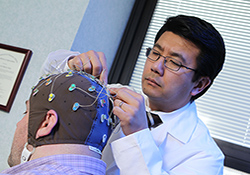Office of Research & Development |
 |

VA Research Currents archive
March 20, 2014

Dr. K. Luan Phan adjusts a volunteer's electrode cap. The researcher is studying the brain's "error alert" system as a potential key to stress resilience. (Photo by Jerry Daliege)
To err is human. Every day people forget to lock their door, pay a bill, or yield at a stop light. Like it or not, mistakes are part of life. Now VA researchers are looking at how Veterans with posttraumatic stress disorder react to their own mistakes. The results could reveal clues as to why some Veterans are more resilient to traumatic events than others.
The science of error-related negativity, or ERN, is one way to study electrical activity in the brain. It works like this: When someone makes a mistake, the brain releases an electrocortical response. Think of the old science fiction movies where test subjects are shocked for answering incorrectly. The brain works in something of the same way, delivering a negative electrical signal whenever an error is made.
"Every time we make an error, our brain consciously or unconsciously recognizes it and lets us know," says Dr. K. Luan Phan, a professor at the University of Illinois, Chicago, and chief of neuropsychiatric research at the Jesse Brown VA Medical Center. "It's a neural signal so that we don't keep making the same error in the future."
Researchers suspect that higher intensities of ERN are tied to anxiety disorders, while lower intensities have been identified in people with depression. "We've known for about 20 years that ERN is elevated in people with obsessive compulsive disorders and that adds to their sense that something isn't right, so they may check the doorknob repeatedly to ensure they locked it," says Phan. "And in the last five years we've found increasing evidence tying ERN to a number of anxiety disorders. Until recently though, no one had studied how ERN interacted with traumatic experience and PTSD."
On the surface, it seemed to make sense. PTSD is characterized by sustained anxiety and hypervigilance. Phan suspected that patients with PTSD would have greater concerns of mistakes and greater brain reactions to making mistakes, as evidenced by ERN.
Thirty four Iraq and Afghanistan Veterans from the Ann Arbor Healthcare System were recruited for the study. While all 34 had experienced combat trauma, only 16 met the diagnosing criteria for PTSD. Another 16 presumably healthy participants without any history of trauma were recruited locally. The participants took a version of the Eriksen flanker task, a simple, timed conflict test involving lines of arrows. In some instances, the arrows would all point in the same direction. In others, they would appear at random which makes it harder to perform and increases the likelihood of making mistakes.
The participants were asked to click on either the left or right mouse button, depending on which direction the arrows faced. Throughout the test, the Veterans were monitored by an electroencephalographic (EEG) recording device.
"We expected to see higher ERN magnitude among patients with PTSD," said Phan, "but were surprised to not observe this. In fact, the PTSD group scored very similarly with the healthy group." This, according to Phan, is actually good news. "It means individuals with PTSD are still able to generate healthy signals for errors in their brains, which may help them not make the same mistakes over and over again."
What did come as a surprise to Phan were the EEG measures in the 18 combat-exposed Veterans who did not have PTSD. In comparison to both the PTSD and healthy groups, the combat-exposed group displayed blunted error signals. In other words, they had lower-than-normal ERN intensity.
The study, which was published in the July 30, 2013, edition of Psychiatry Research: Neuroimaging, suggests that for some people, having a less active error-monitoring system could make them more resilient to developing PTSD from combat trauma.
"We know all the participants had combat trauma exposure, but many came back unscathed at the time of our data collection," says Phan. "Perhaps not being so sensitive to errors in your environment is actually protective. It might allow for the reduction of PTSD and anxiety disorders."
While his study results need to be confirmed through further testing, he hopes one day scientists will learn how to therapeutically manipulate the ERN system for patients' benefit: "If we can reduce the error signals, then maybe we can reduce PTSD," says Phan, who is quick to point out that he's looking years into the future. "First we need to replicate what we saw, but this gives us something to track."